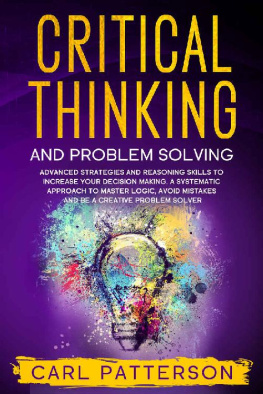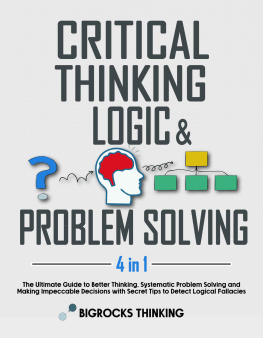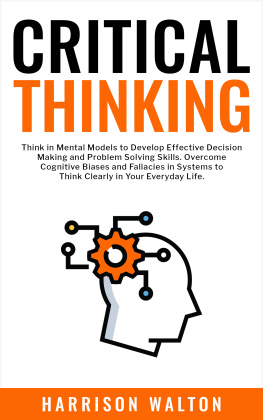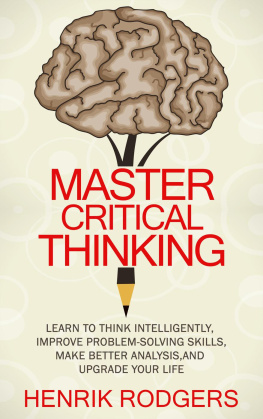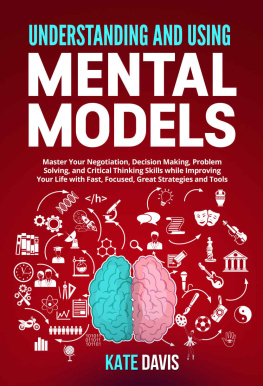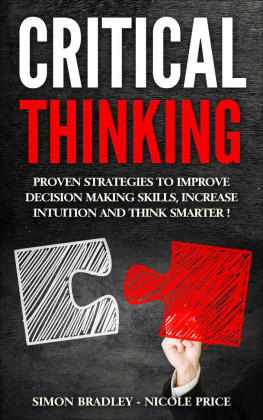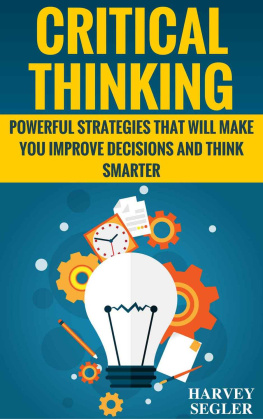Mental Models
The Most Effective Techniques to go from Negative Thinking to Critical Thinking. How to Revamp your Inner Self, Improve your Productivity and Problem Solving Skills to Reach any Goal
By Dr. Kevin Carol Miyake
Copyright 2019 - All rights reserved.
The content contained within this book may not be reproduced, duplicated or transmitted without direct written permission from the author or the publisher.
Under no circumstances will any blame or legal responsibility be held against the publisher, or author, for any damages, reparation, or monetary loss due to the information contained within this book. Either directly or indirectly.
Legal Notice:
This book is copyright protected. This book is only for personal use. You cannot amend, distribute, sell, use, quote or paraphrase any part, or the content within this book, without the consent of the author or publisher.
Disclaimer Notice:
Please note the information contained within this document is for educational and entertainment purposes only. All effort has been executed to present accurate, up to date, and reliable, complete information. No warranties of any kind are declared or implied. Readers acknowledge that the author is not engaging in the rendering of legal, financial, medical or professional advice. The content within this book has been derived from various sources. Please consult a licensed professional before attempting any techniques outlined in this book.
By reading this document, the reader agrees that under no circumstances is the author responsible for any losses, direct or indirect, which are incurred as a result of the use of information contained within this document, including, but not limited to, errors, omissions, or inaccuracies.
Table of Contents
Introduction
Thank you for choosing Mental Models: The Most Effective Techniques to go from Negative Thinking to Critical Thinking. How to Revamp your Inner Self, Improve your Productivity and Problem Solving Skills to Reach any Goal . It is our hope that the information in these chapters will provide information you can use to achieve your goals in life.
The following chapters will discuss the subject of mental models. Mental models, at their most basic level, are an explanation of the thought process one has regarding the way things in the real world work. The relationship between the various parts of what is being analyzed along with ones own actions, feelings, consequences, etc., is taken into account to interpret potential consequences, outcomes, and more.
This is mostly a very detailed breakdown of a process that occurs quite organically and seemingly involuntarily. To keep track of mental models, analyze them, and change them is a very basic part of mastering your mental fortitude and eliminating the barriers that stand between you and what you want in life. When you think about what it is that keeps you from achieving the things you want in life, you will generally find that some combination of your mindset and external circumstances are what prevented success.
Knowing this, we take the next step to unravel that mental process. The more factors of which we can take control of a situation, the more likely it is that well successfully emerge. That makes a good bit of sense, doesnt it? Thats the aim of this book and the information in it.
Mental models are the way in which we interpret the world, the things in it, and the things that go on in life. They influence how we think and our very interpretations of every event in life, while simultaneously influencing the opportunities and connections we see as viable and available.
A mental model, simply put, is a representation of the simple mechanics on something. This is a very broad statement, but mental models are inherently broad, as you can apply a model to literally anything in life. Its impossible for us to keep every minute detail of everything we encounter in the world, so these models act to simplify the more complex aspects of life into more digestible and organizable units.
The nature and quality of our thought processes are proportional to the mental models weve identified and their suitability for the situation currently at hand.
The more models with which youre familiar, the more likely you are to be equipped to accurately understand and to deal with the situation in front of you. When youre evaluating how best to overcome or resolve a situation, the more resources you have to hand, the more easily youll be able to reach a positive conclusion.
Most of us have a particular focus or specialization for the models we adopt, which is based on our personal and work experience. For example, someone who works in engineering might think of things in more of systematic way, while someone who deals with children for a large part of their day would think in terms of incentives or rewards. By pinpointing the type of mindset, we have and by systematically broadening our scope and arsenal of mental models, we can see things from a more panoramic perspective. By being able to do so, we eliminate the possibilities of blind spots forming in our thought process.
While nothing is guaranteed in life, there is still something to be said for understanding as much as we can about the human thought process, the patterns it follows, and how you can use that to improve your odds of success.
The term mental model dates back to 1943 when Kenneth Craik, in his book The Nature of Explanation, indicated that children create mental models as a way of understanding the world around them. He further stipulated that humans hold small models of representations of reality that they use to make decisions, reason, and solve problems. Johnson-Laird, in 1983, also suggested that humans create models of their environment and use them in finding solutions to their problems.
Norman, another pioneer in the field of mental models indicated that the internal representations that people create of the systems with which they interact provide them with an explanatory as well as a predictive capacity for understanding the interactions and systems they encounter. The common concept put forth by these pioneers was that models were an individual's interpretation of their experiences and environment and how these interpretations are applied to facilitate reasoning, explanations, decision-making, finding solutions to problems, and in the prediction of outcomes.
Mental models theory also looks at how mental models influence behavior. Gentner and Stevens (1983) indicated that models are useful tools in the understanding of human behavior. In 1984, Kieras and Bovair stipulated that highly experienced users who had complete knowledge and understanding the model of a device were more adept at using the device compared to those who did not have an associated model. Similarly, Fein, Olson, and Olson in 1993 found that individuals who acquired mental models were more efficient in using complex devices.
In 2002, Sloane reported that individuals with more than one model of internet surfing were found to use different methods to search for another internet. This implied that the more models the person had the more options and methods they would have at their disposal in accomplishing various tasks. Mental model completeness was found to predict the trust level of users to an adaptive cruise control system in flight (Beggiato & Kriems 2013)
In 2002, Gentner found that the primary prediction method in mental models involved simulation. Simulating a model was found to predict the outcome of the interaction of the user with the system he was in contact with. It was found that by using stored knowledge, people could simulate future states of the particular system in question. These simulations result in the quick execution of actions that are reliant on preexisting knowledge. Using this preexisting knowledge was found to be related to automatic processing of information which resulted in low effort actions that are predominantly based on procedural knowledge. On the other hand, mental simulations that rely on cognitive knowledge were found to be slow in execution.


